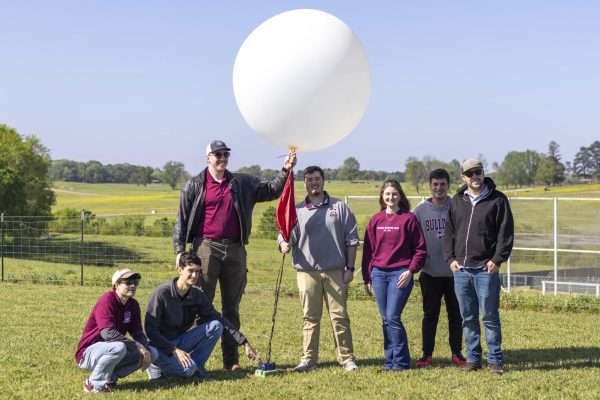The weather was 55 degrees with clear skies — ideal conditions for a launch. The only problem was the wind. A steady five-mile-per-hour southern breeze threatened to carry CubeSat’s first weather balloon, Desperado I, directly into Buff Lake at the Noxubee National Wildlife Refuge.
Luckily, some team members were prepared to swim.
CubeSat, a Mississippi State University student organization dedicated to designing and building satellites, launched Desperado I on April 12 at the Howell Observatory in what they hope will be the first of three critical missions toward their ultimate goal—to launch a satellite into orbit, ideally by 2028. Currently, Mississippi is one of two states that have never launched a satellite.
CubeSat was formed in 2019 to give students hands-on aerospace engineering experience while contributing to space innovation in Mississippi. The club is split into three subteams: structures, instruments and GNC — short for guidance, navigation and control. Club President Sloan Berry, a sophomore aerospace engineering major, said that CubeSat is all about collaboration.
“Structures handles the cube’s frame and parachute, instruments works on the sensors and codes and GNC manages the ground station,” Berry said.
CubeSats — named for their cube-like shape — are a standard class of small, modular satellites used in research, communications and space exploration.
With the help of the university’s meteorology department, CubeSat borrowed a 200-gram weather balloon and received up-to-date weather tracking and wind trajectory data for the launch site. The payload — a 1U cube satellite, or a cube-shaped satellite that is 10 centimeters on each side — was loaded with a Raspberry Pi Zero 2 W processor, a transceiver radio, GPS module, an Airtag for recovery and a parachute to slow the descent once the balloon popped. The payload was designed to transmit real-time atmospheric data to a ground station that the team built themselves. In the event of transmission failure, data was also backed up on an SD card inside the payload.
Aside from testing communications, the Desperado I project also aimed to collaborate with other student organizations like the Space Cowboys and Xipiter Unmanned Aerial Systems, which both receive bonus points in their competitions if their payload, or cargo that is being transported, is a CubeSat.
Before the launch, the team’s first balloon burst during the helium inflation, but a larger backup balloon was on hand. With the payload secured with zip ties and the parachute double-checked, the final checks began. After a group picture, Daniel Hurley, the team’s chief engineer and a junior aerospace engineering major, started the countdown as a few members readied themselves to sprint to their cars to follow the balloon.

“Chase cars a go?” Hurley said, looking at his clipboard. “Okay. T-minus five, four, three, two, one.”
And with that, Desperado I was released and rose into the sky.
On the ground, CubeSat members sprinted to their cars. Two chase cars followed the balloon from below, heading south on Oktoc and Pike Road. They scanned the skies for any trace of the balloon while mission control stayed at the observatory and managed to read the communications the satellite was pinging to the ground.
Not long after launch, mission control lost communication with the satellite. A chase car spotted it briefly off Oktoc Road, but they lost it. Hurley, who was in a chase car, called mission control while instruments lead Eli Frazure, a senior electrical engineering major, told him about the data.
“We haven’t picked up a ping in a couple of minutes,” said Frazure. “We’re not getting any GPS coordinates, too; it could have come down.”
Berry blamed the loss on the unreliable weather data they were given.
“We were told the balloon would be in the air for at most an hour,” Berry said. “But we think it actually stayed up there for about three and a half hours.”
That extended flight pushed the balloon much farther than expected — possibly across state lines.
“It’s likely drifted well into Alabama at this point,” Berry said. “We’re hoping our GPS or Airtag will ping off something soon. Our contact info is on [the satellite].”
Despite losing the payload, the team is calling the mission a success.
“The whole point of the mission was to test our ground station capabilities and our communication system,” Berry said. “We’ve established a link with the same system we plan to use for 1-Mississippi. That was the mission objective. Recovering the payload would have just been a bonus.”
The next major step for CubeSat is a partnership with the University of Louisiana at Lafayette on their CAPE-4 satellite mission. The MSU team will provide a communications payload that will fly aboard the CAPE-4 satellite and transmit data back to campus.
“This summer and next semester, we’re focused on our collaboration with the University of Louisiana at Lafayette,” Berry said. “They’ve given us a spot on their CAPE-4 satellite to fly a similar communications payload. That’ll be our first real space communication test.”
Ultimately, CubeSat hopes to launch 1-Mississippi, a 3U CubeSat equipped with near-infrared imaging systems designed to detect wildfires, algae blooms and other environmental hazards. The team plans to submit the satellite to NASA’s Educational Launch of Nanosatellites CubeSat Launch Initiative, which is NASA’s initiative that serves to educate students and see every state launch its own satellite. 1-Mississippi will request deployment from the International Space Station.
“We’ve had some ups and downs getting this club off the ground — literally and figuratively,” Berry said. “But now that we’ve launched something, tracked it and collected real data, we feel legitimate. We’re making real progress toward space.”
The team welcomes new members from all majors, not just engineering.
“You don’t have to be an engineer — we’d love to have more students who want hands-on experience in something really exciting,” Berry said.








